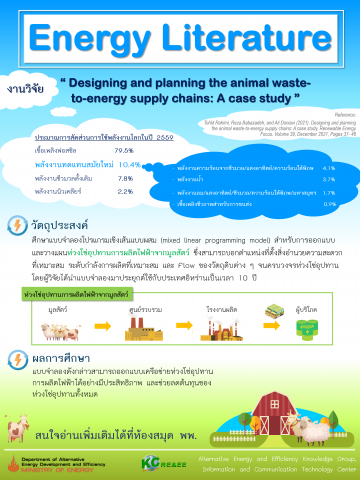Designing and planning the animal waste-to-energy supply chains: A case study
Abstract
The need for clean energy and fossil fuel depletion are the reasons behind the increasing tendency to utilize renewable energy resources. Biogas as the final product of anaerobic fermentation of some sources including animal waste, could be used in distributed electricity generation. This paper presents a mixed linear programming model for designing and planning of electricity production supply chain from animal manure. The proposed model determines the optimum locations for establishing facilities, optimum capacity level, and material flow throughout the supply chain. Multiple suppliers, collection centers and production centers, and multi-period conditions are considered in the proposed model. The proposed model is applied in a real case of Iran including all its 30 provinces for 10 years planning horizon. The achieved results confirm the capability of the proposed model in efficient design of electricity production chain network.
Reference: Tohid Rahimi, Reza Babazadeh, and Ali Doniavi (2021). Designing and planning the animal waste-to-energy supply chains: A case study. Renewable Energy Focus. Volume 39, December 2021, Pages 37-48
บทคัดย่อ
ความต้องการใช้พลังงานสะอาดและการขาดแคลนเชื้อเพลิงฟอสซิลเป็นสาเหตุเบื้องหลังการเพิ่มขึ้นของการใช้พลังงานหมุนเวียน ก๊าซชีวภาพเป็นผลิตภัณฑ์ขั้นสุดท้ายที่ได้จากกระบวนการหมักย่อยสลายแบบไม่ใช้ออกซิเจน (anaerobic fermentation) ของสารอินทรีย์ต่าง ๆ รวมไปถึงของเสียจากสัตว์ ซึ่งสามารถนำมาใช้ในการผลิตไฟฟ้าได้ บทความนี้ได้นำเสนอแบบจำลองโปรแกรมเชิงเส้นแบบผสม (mixed linear programming model) สำหรับการออกแบบและวางแผนห่วงโซ่อุปทานการผลิตไฟฟ้าจากมูลสัตว์ แบบจำลองดังกล่าวสามารถบอกตำแหน่งที่ตั้งสิ่งอำนวยความสะดวกที่เหมาะสม ระดับกำลังการผลิตที่เหมาะสม และ flow ของวัตถุดิบต่าง ๆ จนครบวงจรห่วงโซ่อุปทาน นอกจากนี้ ในแบบจำลองยังได้คำนึงถึงความหลากหลายของวัตถุดิบ ศูนย์รวบรวม โรงงานผลิต รวมถึงเงื่อนไขของช่วงเวลาที่ต่างกัน โดยผู้วิจัยได้นำแบบจำลองมาประยุกต์ใช้กับประเทศอิหร่านทั้ง 30 จังหวัด เป็นเวลา 10 ปี ผลการศึกษาพบว่า แบบจำลองดังกล่าวสามารถออกแบบเครือข่ายห่วงโซ่อุปทานการผลิตไฟฟ้าได้อย่างมีประสิทธิภาพ
อ่านฉบับเต็มได้ที่ ห้องสมุด พพ.

